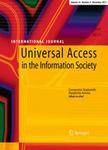版权所有:内蒙古大学图书馆 技术提供:维普资讯• 智图
内蒙古自治区呼和浩特市赛罕区大学西街235号 邮编: 010021

作者机构:Interaction Design Lab. Department of Information Systems University of Melbourne Carlton Vic. 3010 111 Barry St. Australia
出 版 物:《Universal Access in the Information Society》 (Univers. Access Inf. Soc.)
年 卷 期:2006年第4卷第3期
页 面:204-222页
学科分类:0810[工学-信息与通信工程] 1205[管理学-图书情报与档案管理] 0839[工学-网络空间安全] 08[工学] 0835[工学-软件工程] 0811[工学-控制科学与工程] 0812[工学-计算机科学与技术(可授工学、理学学位)]
主 题:Universal interface User agent User model
摘 要:Intelligent agents can play a pivotal role in providing both software systems and augmented interfaces, to individual users from all walks of life, to utilise the Internet 24 h a day, 7 days a week (24×7), including interaction with other users, over both wireless and broadband infrastructures. However, traditional approaches to user modelling are not adequate for this purpose, as they mainly account for a generic, approximate, idealised user. New user models are therefore required to be adaptable for each individual and flexible enough to represent the diversity of all users using information technology. Such models should be able to cover all aspects of an individual s life - those aspects of most interest to the individual user themselves. This paper describes a novel intelligent agent architecture and methodology both called ShadowBoard, based on a complex user model drawn from analytical psychology. An equally novel software tool, called the DigitalFriend based on ShadowBoard, is also introduced. This paper illustrates how aspects of user cognition can be outsourced, using, for example, an internationalised book price quoting agent. The Locales Framework from Computer Supported Co-operative Work is then used to understand the problematic aspects of interaction involved in complex social spaces, identifying specific needs for technology intervention in such social spaces, and to understand how interactions amongst mobile users with different abilities might be technically assisted in such spaces. In this context, the single user-centred multi-agent technology demonstrated in the DigitalFriend is adapted to a multi-user system dubbed ShadowPlaces. The aim of ShadowPlaces is to outsource some of the interaction necessary, for a group of mobile individuals with different abilities to interact cooperatively and effectively in a social world, supported by wireless networks and backed by broadband Internet services. An overview of the user model, the architecture and